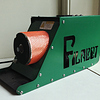Last week we tried our brand new Filabot, the magical machine that turns plastic pellets into filament, and even turns failed prints into recycled material.
When you use a 3d printer often you know the process of 3D printing goes hand in hand with lots of trial and error. Ever so often we are left with bundles of strings after we leave our machine printing overnight at the 3D Hubs HQ. Besides the disappointment of a failed print, we also regret having to throw away all that wasted filament. Therefore we were very pleased with the arrival of our Filabot last week.

For those of you who haven’t heard of Filabot 23; it’s a machine that primarily grinds small plastic pellets and extrudes them into your very own filament. What’s even more exciting is that it also allows for recycling your failed 3D prints, after you cut them up into consumable little pieces.
We were very excited to start using this wonderful machine. The set-up was fairly easy, as it was already assembled on delivery. We decided to play it safe for the first run, with the following set up:
Filabot settings:
- White ABS pellets
- 170 Cº
- Manually spooled
Ultimaker Original settings:
- Marvin print
- 0.06mm layer height
- 250 Cº
- One piece of Filabot filament pushed forward by regular filament
The outcome of this first set-up was a bit disappointing. Since we had to manually spool the filament coming from the Filabot, the diameter was as constant as our manual spooling. Not that great. It came out thicker than 3mm and after we stretched it we lost track of the right diameter, leaving us with a wobbly string of filament.
However this didn’t stop us from trying to print with it. We decided to cut one piece of ‘evenly wide’ filament and let it be pushed forward by regular filament, to print our Mascot Marvin.
When the Ultimaker started printing our homemade filament our jaws dropped. It was pretty cool. However it was quickly followed by slight disappointment after the print was finished. Our Marvin looked like a beat-up Martian.

Wondering how we could improve the results, we got on the phone with the Filabot team, who gave us some useful advice for our next run:
don’t spool manually, but let the filament drop on the floor. This will stretch the filament to the right diameter (3mm). Also lower the temperature of the Ultimaker. 250 Cº is too hot for the Filabot filament to print well, making it messy like you can see in the picture.
Next week - after the fumes have cleared - we’ll give it another go, and report back to you. Until then feel free to tweet @gerritsluuk 1 with tips and tricks for the Filabot if you are one of the happy few that already owns this little plastic eating beast!
created
Dec '14last reply
Feb '15- 4
replies
- 5.4k
views
- 2
users
- 5
likes
- 4
links

